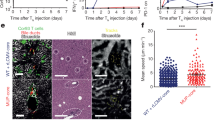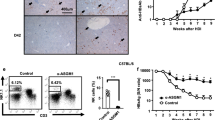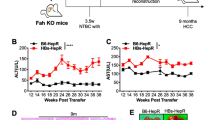Abstract
Hepatic adeno-associated virus (AAV)-serotype 2 mediatedgene transfer results in transgene product expression that is sustained in experimental animals but not in human subjects. We hypothesize that this is caused by rejection of transduced hepatocytes by AAV capsid–specific memory CD8+ T cells reactivated by AAV vectors. Here we show that healthy subjects carry AAV capsid–specific CD8+ T cells and that AAV-mediated gene transfer results in their expansion. No such expansion occurs in mice after AAV-mediated gene transfer. In addition, we show that AAV-2 induced human T cells proliferate upon exposure to alternate AAV serotypes, indicating that other serotypes are unlikely to evade capsid-specific immune responses.
This is a preview of subscription content, access via your institution
Access options
Subscribe to this journal
Receive 12 print issues and online access
$209.00 per year
only $17.42 per issue
Buy this article
- Purchase on Springer Link
- Instant access to full article PDF
Prices may be subject to local taxes which are calculated during checkout


Similar content being viewed by others
References
Manno, C.S. et al. Nat. Med. 12, 342–347 (2006).
Sabatino, D.E. et al. Mol. Ther. 12, 1023–1033 (2005).
Gao, G.P. et al. Proc. Natl. Acad. Sci. USA 99, 11854–11859 (2002).
Appay, V. et al. Nat. Med. 8, 379–385 (2002).
Mount, J.D. et al. Blood 99, 2670–2676 (2002).
Wang, L., Nichols, T.C., Read, M.S., Bellinger, D.A. & Verma, I.M. Mol. Ther. 1, 154–158 (2000).
Snyder, R.O. et al. Nat. Med. 5, 64–70 (1999).
Muzyczka, N. & Berns, K.I. Parvoviridae: The Viruses and Their Replication, 2327–2359 (Lippincott Williams & Wilkins, Philadelphia, 2001).
Vandenberghe, L.H. et al. Nat. Med. 12, 967–971 (2006).
Acknowledgements
This work was supported by US National Institutes of Health (NIH) grants P01 HL078810, M01-RR00240 (NIH GCRC award to Children's Hospital of Philadelphia), M01-RR000056 (NIH GCRC award to University of Pittsburgh), a grant to the Penn Center for AIDS Research P30 AI045008 and the Howard Hughes Medical Institute. D.J.H. was supported by training grant NIH T32 HL07439, S.L.M. by training grant NIH T32 DK07748 and D.E.S. by NIH F32 HL69647. We thank F. Lemonnier (Institute Pasteur) for kindly providing HLA-B*0702 transgenic mice. We thank M. Lasaro and M. Tigges for scientific input, and J. Sun for assistance in manuscript preparation.
Author information
Authors and Affiliations
Contributions
F.M. and M.V.M. performed the in vitro expansion experiments on normal donors and expansions on subjects with hemophilia B. They performed intracellular cytokine assays, the cytotoxic T lymphocyte (CTL) assay, the pentamer staining, the immunophenotyping of memory CD8+ T cells specific to the AAV capsid and the cross-reactivity experiments. D.J.H. performed experiments on human splenocytes and the AAV epitope characterization. D.E.S. performed in vitro expansion experiments on subjects with hemophilia B enrolled in the gene transfer study and part of the ELISpot studies on healthy donors. S.L.M. performed the experiments on HLA-B*0702 transgenic mice. H.J. and J.S. performed part of the ELISpot studies and AAV antibody titer determination on normal donors. C.S.M., M.V.R. and J.E.J.R. directed and/or participated in the clinical gene transfer study, including the care of hemophilic subjects, and collection of PBMCs used in the study. They provided assistance in drafting the manuscript. H.C.J.E. and G.F.P. collaborated on experimental design and interpretation, and helped to draft the manuscript. K.A.H. directed experimental design, conduct, data analysis and interpretation, and drafted the manuscript.
Corresponding author
Ethics declarations
Competing interests
J.S., H.J. and G.F.P. were employees of Avigen, Inc. at the time the work was done. F.M., D.J.H. and K.A.H. hold pending patent applications that may be affected by publication of this manuscript.
Supplementary information
Supplementary Fig. 1
Immunophenotyping of capsid-specific CD8+ T cells in a healthy donor. (PDF 192 kb)
Supplementary Table 1
AAV capsid epitopes defined by IFN-γ ELISpot assays of normal donors and of AAV-infused subjects (PDF 56 kb)
Supplementary Table 2
Neutralizing antibody and cellular immune responses, sera and PBMCs from adult human subjects (PDF 48 kb)
Supplementary Table 3
IFN-γ ELISpot responses to AAV capsid in unexpanded and peptide-expanded human splenocytes (PDF 58 kb)
Rights and permissions
About this article
Cite this article
Mingozzi, F., Maus, M., Hui, D. et al. CD8+ T-cell responses to adeno-associated virus capsid in humans. Nat Med 13, 419–422 (2007). https://doi.org/10.1038/nm1549
Received:
Accepted:
Published:
Issue Date:
DOI: https://doi.org/10.1038/nm1549
This article is cited by
-
Multicenter assessment and longitudinal study of the prevalence of antibodies and related adaptive immune responses to AAV in adult males with hemophilia
Gene Therapy (2024)
-
Prednisolone and rapamycin reduce the plasma cell gene signature and may improve AAV gene therapy in cynomolgus macaques
Gene Therapy (2024)
-
Molecular functions of microRNAs in colorectal cancer: recent roles in proliferation, angiogenesis, apoptosis, and chemoresistance
Naunyn-Schmiedeberg's Archives of Pharmacology (2024)
-
Immune profiling of adeno-associated virus response identifies B cell-specific targets that enable vector re-administration in mice
Gene Therapy (2023)
-
Clonal selection of hematopoietic stem cells after gene therapy for sickle cell disease
Nature Medicine (2023)



